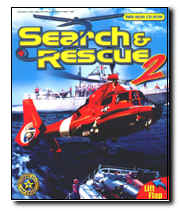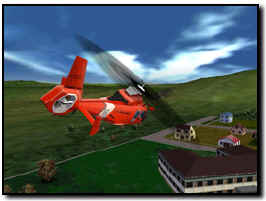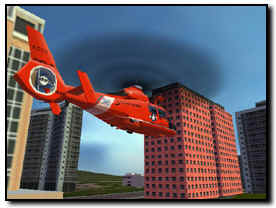|
SEARCH AND RESCUE II reviewed by Matt "LIONPRIDE" Starace |
|
I was very excited to see this product come across my desk when it did. A Coast Guard Navigator by trade, I was more than a little excited to try this sim out. The box felt light, but there was a more than an adequate manual inside with a rather flimsy jewel case for the CD. Upon startup after a slightly problematic installation, unstable CD in the drive, the intro had me all choked up and proud to be part of the team. There are several choices for getting started and they range from selecting the FM (realistic flight model or arcade mode) to the graphics detail to sound options and sound effects. Choosing a single mission or a campaign was the next tough decision to weigh. The single missions consists of a multitude of free flight options and actual missions featured in the campaign. Settings ranging from time of day, weather, and starting positions are all available. In case you like to start your missions ala Gunship (in the air), there's even an option for that. For those requiring a little more hardcore action, you can start right off from the ground and see the chopper through its' startup sequence. The campaign mode is a bit more unforgiving and very challenging with no option to edit these missions.
The damage modeling is excellent. I can count on one hand the helo-sims that show this much damage modeling in them. Wheels will be damaged if you land too hard and might encounter avionics failures or see smoke after flying your fantail into an obstruction. Remember that this isn't a combat helicopter sim. Autorotations, flameouts, and over-torque effects are modeled in the flight model, though a bit "quirky" at times. A 50 or 60 degree bank will cause you to often stall. A foot note from on of the programmers about the flight model-Anton Sorensen : I did the flight model for SAR2, so let me add a few comments on that topic. This does not at all affect your conclusion that the flight model is flawed, but may clear up a few things. The most important lesson was that of how important flapping is. The rotor in SAR2 is completely rigid, and the AFCS works hard on compensating the lack of flapping. When the helicopter is pushed beyond it's limits and a blade stalls, the AFCS flapping fails and an abrupt departure from controlled flight occurs. I agree that one would never certify a real helicopter with such unforgiving nature. A patch is scheduled by the team at InteractiveVision in the near future to fix these flight model problems. Though the flight model is hailed by some as one of the best around while others will swear it belongs in the trash. The best way to describe this flight model is to say it has the best of Good and Evil. Training missions are also available and believe me, you would want to run through them before you fly the actual mission since your hard earned rank and campaign will come to an abrupt end after many successful missions if you crash even once. Surprisingly, there's no option to save your game. The weather, buildings, and mountains are your enemy in this sim. The weather is modeled very nicely too. Another nice touch is the 'time jump' option. This is a neat little tool that comes in handy when your jaw drops after seeing 100+miles distance to your next mission goal. Getting up to speed, pointing in the right direction the feature will ease a long transition time, dropping you about 6 - 7 miles from your objective location.
Poor framerates at the highest detail settings prevented me from enjoying SAR 2 in all it's glory. When I did set to a high detail however, it wasn't much more appealing. (The reviewer had used an AMD 500mhz K6II series with 128mb of RAM and an nVida Vanta card for the review.) The 3D cockpit was in essence a disappointment; it's usefulness only provides for the flight mechanic view and watch the engine, fuel boost pumps and rotor brake levers move. However, it does have an advantage. Not only do you get the perspective of the flight mechanic at the door, but it's also great for viewing your approach to the targets via a 'manual' padlock so to speak. To summarize, depending on your system specs, graphics are above average, physics are some of the best around and the approach to this sim is refreshing. For the street-price of $20.00, you can't beat it! It's a fun ride in any mode you choose but no Hellfires here! It's tougher than you may think.
A quick correspondence with Commander Norman Schweizer, one of the Coast Guard liaison for the developers at InteractiveVision. Since this sim clearly states that it models U.S. Coast Guard procedures and helicopter operations, why not get some thoughts from one of their sources? Q. . How much 'say' did you actually have in the development in this sim?A . I had very little to say in developing the sim. As a helo pilot I described the types of cases we encounter.Q. . The sim seems rather difficult to fly for the 'average' gamer picking this off of the shelves at the store. Were you told that this sim would be geared towards the 'hardcore' community of simmers or the general game playing public?A . I was not advised of the target user.Q. . Was your role just to test the beta versions as development went on? and if so, did the developers take your ideas into account?A . I did some beta testing and provided feedback as to the helicopter's response and operation.Q. . I noticed a poor attention to detail on the side of the afloat units modeled. what's your 'take' on that?A . My focus was on the aircraft/helicopter realism. I did not focus on the surface side.Q. . Was there any reason why they didn't model the HH-60 Jayhawk?A . I have no idea why the HH65 was chosen and not the 60. However, the "Baywatch" appeal of the dolphin may have been an issue.
HeloSim's Rating - 6 out of 10 |

 Getting off the ground consisted of actually giving the engines fuel flow thru two levers and releasing the rotor brake. After waiting what seemed like an eternity, the rotors started to spin up. I was amazed at the amount of movement that this helo made while sitting on the pad. I'd call it a 'Penguin Jig'. One of the neatest things I've seen in awhile happened when I gave it a little juice - the landing gear shocks actually modeled the release of pressure realistically! Rotor downwash and torque effects were evident when powering up the main rotor systems up to ideal RPMs. Coming from a realism standpoint, the use of a checklist and the actual engine spool up would have taken far longer and in light of this being a simulation and not a training aid, having it omitted was for the best in our opinion. As the engines spool up, watch the tachometers and make sure your RPM is in the green before you start your takeoff. Don't forget to introduce the fuel via boost pumps and watch your torque meters.
Getting off the ground consisted of actually giving the engines fuel flow thru two levers and releasing the rotor brake. After waiting what seemed like an eternity, the rotors started to spin up. I was amazed at the amount of movement that this helo made while sitting on the pad. I'd call it a 'Penguin Jig'. One of the neatest things I've seen in awhile happened when I gave it a little juice - the landing gear shocks actually modeled the release of pressure realistically! Rotor downwash and torque effects were evident when powering up the main rotor systems up to ideal RPMs. Coming from a realism standpoint, the use of a checklist and the actual engine spool up would have taken far longer and in light of this being a simulation and not a training aid, having it omitted was for the best in our opinion. As the engines spool up, watch the tachometers and make sure your RPM is in the green before you start your takeoff. Don't forget to introduce the fuel via boost pumps and watch your torque meters.  The flight mechanic has a Southern California accent that is so bad that you'd think he rolled up to flight check on his skateboard. Vehicle interaction is just about non-existent. I landed a few times on the street for a mission or two and while doing a pickup, I've had a number of automobiles drive right through my bird. Not only did they drive through me, but also they drove right through the accident scene. While I'm on the subject, another interesting note: when you see the crewman deploy the stretcher it's a funny thing to watch. A good way to describe it is a 'Gumby Walk'. Their feet don't move and they phase through all the objects they come into contact with. While on negatives, wind also has no bearing on smoke effects. Wind direction is a very real issue in this sim but one can't tell where wind is coming from by looking at smoke stacks. It's detracting to see vertical smoke stacks when you know there's wind coming from another direction. Upon returning to base, You have to land exactly within' the helipad circle markings before they stop the mission and call it a 'win'. That's where the wheel brakes come into play. I drove the 'parade route' for a good look around the base. The uniform center was closed for the day - oh well. This thing sure doesn't corner very well and it ain't no Porsche but it leans realistically in the turns though, very cool indeed.
The flight mechanic has a Southern California accent that is so bad that you'd think he rolled up to flight check on his skateboard. Vehicle interaction is just about non-existent. I landed a few times on the street for a mission or two and while doing a pickup, I've had a number of automobiles drive right through my bird. Not only did they drive through me, but also they drove right through the accident scene. While I'm on the subject, another interesting note: when you see the crewman deploy the stretcher it's a funny thing to watch. A good way to describe it is a 'Gumby Walk'. Their feet don't move and they phase through all the objects they come into contact with. While on negatives, wind also has no bearing on smoke effects. Wind direction is a very real issue in this sim but one can't tell where wind is coming from by looking at smoke stacks. It's detracting to see vertical smoke stacks when you know there's wind coming from another direction. Upon returning to base, You have to land exactly within' the helipad circle markings before they stop the mission and call it a 'win'. That's where the wheel brakes come into play. I drove the 'parade route' for a good look around the base. The uniform center was closed for the day - oh well. This thing sure doesn't corner very well and it ain't no Porsche but it leans realistically in the turns though, very cool indeed.